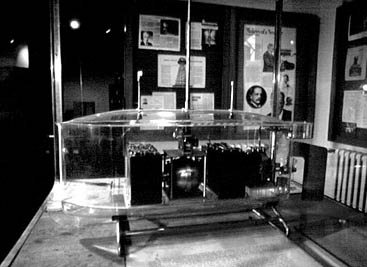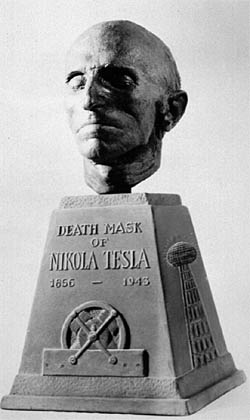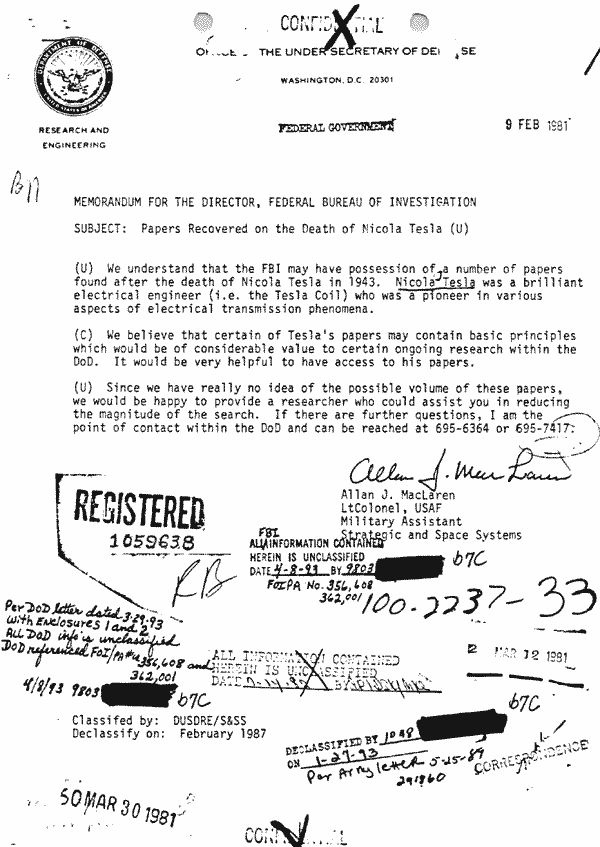
Nikola Tesla |
||||||
| Tesla Life and Legacy The Missing Papers | ||||||
| PBS report
Original Source Date: Unknown |
||||||
|
One of the more controversial topics involving Nikola
Tesla is what became of many of his technical and scientific papers after
he died in 1943. Just before his death at the height of World War II, he
claimed that he had perfected his so-called "death beam." So it was natural
that the FBI and other U.S. Government agencies would be interested in
any scientific ideas involving weaponry. Some were concerned that Tesla's
papers might fall into the hands of the Axis powers or the Soviets.
The morning after the inventor's death, his nephew Sava Kosanovic´ hurried to his uncle's room at the Hotel New Yorker. He was an up-and-coming Yugoslav official with suspected connections to the communist party in his country. By the time he arrived, Tesla's body had already been removed, and Kosanovic´ suspected that someone had already gone through his uncle's effects. Technical papers were missing as well as a black notebook he knew Tesla kept—a notebook with several hundred pages, some of which were marked "Government." P. E. Foxworth, assistant director of the New York FBI office, was called in to investigate. According to Foxworth, the government was "vitally interested" in preserving Tesla's papers. Two days after Tesla's death, representatives of the Office of Alien Property went to his room at the New Yorker Hotel and seized all his possessions. Dr. John G. Trump, an electrical engineer with the National Defense Research Committee of the Office of Scientific Research and Development, was called in to analyze the Tesla papers in OAP custody. Following a three-day investigation, Dr. Trump concluded: His [Tesla's] thoughts and efforts during at least the past 15 years were primarily of a speculative, philosophical, and somewhat promotional character often concerned with the production and wireless transmission of power; but did not include new, sound, workable principles or methods for realizing such results. Just after World War II, there was a renewed interest in beam weapons. Copies of Tesla's papers on particle beam weaponry were sent to Patterson Air Force Base in Dayton, Ohio. An operation code-named "Project Nick" was heavily funded and placed under the command of Brigadier General L. C. Craigie to test the feasibility of Tesla's concept. Details of the experiments were never published, and the project was apparently discontinued. But something peculiar happened. The copies of Tesla's papers disappeared and nobody knows what happened to them. In 1952, Tesla's remaining papers and possessions were released to Sava Kosanovic´ and returned to Belgrade, Yugoslavia where a museum was created in the inventor's honor. For many years, under Tito's communist regime, it was extremely difficult for Western journalists and scholars to gain access to the Tesla archive in Yugoslavia; even then they were allowed to see only selected papers. This was not the case for Soviet scientists who came in delegations during the 1950s. Concerns increased in 1960 when Soviet Premier Khrushchev announced to the Supreme Soviet that "a new and fantastic weapon was in the hatching stage." Work on beam weapons also continued in the United States. In 1958 the Defense Advanced Research Projects Agency (DARPA) initiated a top-secret project code-named "Seesaw" at Lawrence Livermore Laboratory to develop a charged-particle beam weapon. More than ten years and twenty-seven million dollars later, the project was abandoned "because of the projected high costs associated with implementation as well as the formidable technical problems associated with propagating a beam through very long ranges in the atmosphere." Scientists associated with the project had no knowledge of Tesla's papers. In the late 1970s, there was fear that the Soviets may have achieved a technological breakthrough. Some U.S. defense analysts concluded that a large beam weapon facility was under construction near the Sino-Soviet border in Southern Russia. The American response to this "technological surprise" was the Strategic Defense Initiative announced by President Ronald Reagan in 1983. Teams of government scientists were urged to "turn their great talents now to the cause of mankind and world peace, to give us the means of rendering these nuclear weapons impotent and obsolete." Today, after a half-century of research and billions of dollars of investment, the SDI program is generally considered a failure, and there is still no realistic means of defense against a nuclear missile attack. For many years scientists and researchers have sought
for Tesla's missing papers with no apparent success. It is conceivable
that if Nikola Tesla knew a means for accurately projecting lethal beams
of energy through the atmosphere, he may have taken it to the grave with
him.
Since Tesla's papers on particle beam weaponry were last known to be at the base in Dayton, Ohio, the intervention of a Dayton criminal defense attorney or an investigative journalist familiar with uncovering secret government documents might be able to finally get some answers. |
||||||
|
..
Tesla's suite at the hotel New Yorker following his
funeral on January 12, 1943. Left to right: Bogoljub Jevtic´, a member
of the last Royal Government of the Kingdom of Yugoslavia; Professor Boris
Furlan, a Slovene active during the war in the United States, who went
back to Yugoslavia where he was arrested and liquidated brutally; Sava
Kosanovic´, Tesla's nephew and member of the Royal Government in
exile.
Articles in Tesla's hotel room after his death. Note
cabinets and one of the invertor's safes. Three packages of Nabisco crackers
can be seen on one of the upper shelves of the cabinet at left.
A model of Tesla's remote-controlled boat housed at
the Tesla Museum in Belgrade, Yugoslavia.
The library archives at the Tesla Museum in Belgrade,
Yugoslavia.
U.S. satellite reconnaissance photo of suspected Soviet
beam weapon installation near Semipalatinsk. Published July 28, 1980. (Courtesy
Aviation Week & Space Technology)
The death mask of Nikola Tesla in the offices of Gernsback Publications, New York City, in celebration of the Tesla centennial, June 25, 1956. The mask was heavily electroplated with copper, a process that took ten days, and was mounted on a marble-composition pedestal. Three medallions, executed in bas-relief on the base, commemorate Tesla's greatest inventions: the Tesla oscillation transformer, the first AC induction motor, and the tower for wireless power transmission. |
||||||
|
..
|
||||||
|
|











